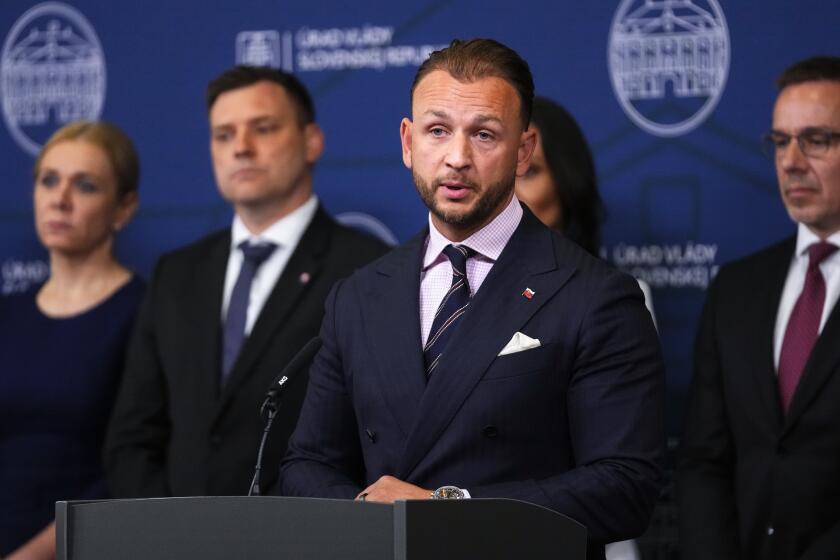Most Hostages Flying Back to U.S. Today
The freed American hostages spent a hectic first day of freedom Monday, describing their 16-day hijacking ordeal to doctors, government officials and reporters, and then decided to leave for home today, one day earlier than scheduled.
“We had another of our famous meetings,” said Jack McCarthy, a San Francisco nightclub owner, referring to what he described as the extraordinary ability of the hostages during their captivity to meet and iron out a common position. “The majority of us are leaving as a group tomorrow, somewhere around 1 or 2 o’clock.”
Trans World Airlines, which had initially planned to fly the 39 freed hostages and their relatives back to the United States on a chartered aircraft Wednesday, confirmed that 61 hostages and family members have signed up to travel today. It was unclear how many of the 39 hostages planned to leave Wiesbaden later.
Reagan to Be on Hand
In Washington, White House officials said President Reagan plans to meet the returning Americans when the flight lands at Andrews Air Force Base in Maryland. It was aboard another TWA airliner--Flight 847 from Athens to Rome--that the ordeal of the 39 began June 14 when the plane was hijacked by two Shia Muslims and forced to Beirut.
The decision to depart for home a day early followed about 12 hours of meetings with loved ones--whom many of the 39 had believed they might never see again--examinations by doctors and talks with FBI agents at the U.S. military hospital here.
The revised departure date is apparently due largely to the unexpectedly strong physical and emotional condition of the freed hostages, despite the almost fragile appearance of some of them on their arrival early Monday.
An Air Force C-141 Starlifter brought them from Damascus, Syria, to U.S. Rhein-Main Air Base at Frankfurt, West Germany, 24 miles east of Wiesbaden.
All 39 Pronounced Fit
Within hours of their emotional return to freedom, all 39 men were pronounced fit after initial physical examinations at the Air Force’s regional medical center here.
“I think they’re in excellent condition,” Col. Charles K. Maffet, commander of the medical center, told reporters. The only ailment to have turned up so far, he said, was a bee sting.
Maffet was also optimistic in his long-term prognosis about the emotional impact of the ordeal.
“These 39 gentlemen are not going to have the problems associated with the Iranian hostages simply because they didn’t spend that much time in captivity,” he said.
The 52 American diplomatic personnel who were held by Iranian militants in Tehran spent a total of 444 days in captivity before being freed in January, 1981.
Initial descriptions by those of the 39 willing to discuss their experiences indicated that the ordeal consisted of two distinct, extremely different phases: a period of terror and violence during the first days aboard the hijacked Boeing 727 jet followed by a period of uncertainty and intense political discussion--but no violence--while being held somewhere in Beirut.
On the second day of the hijacking, the terrorists beat and shot to death one of the Americans, U.S. Navy Petty Officer Robert Dean Stethem.
Hostages generally said they were well-treated after they were off the plane.
“We were never touched by them,” said Vicente Garza, a 53-year-old Laredo, Tex., businessman.
Relating one incident, Garza said that after he complained that his breakfast had failed to come at the usual 9 a.m. hour, his guard went home and brought him a brunch of beans and pita bread.
Degree of Understanding
Judging from some of the hostages’ initial statements to Times correspondents here following their release, long hours of discussions with their captors generated a degree of understanding, if not sympathy, for the hijackers’ cause.
But that feeling was not universal. One of the four who had been held separately, asking not to be identified, referred to the murder of Stethem and disagreed strongly with his fellow hostages who expressed sympathy for the Shia Muslims’ cause.
And Jimmy Dell Palmer, who was one of the original hostages but was freed last week because of a heart ailment, said Monday that he was disturbed over talk of sympathy for the Shias. “I’m being held captive by the people that are trying to indoctrinate me and tell me their cause and how right they are,” he told a reporter in Little Rock, Ark., “and I cannot ignore the fact that I’m being held captive.”
McCarthy, the San Franciscan, expressed pleasure at reports that Israel intends to release 300 Lebanese prisoners soon.
‘300 Nice People’
“After what I’ve been through,” McCarthy said, he would be pleased at the news of the release of “any 300 nice people who are innocent.” Another freed hostage, McCarthy’s friend, Victor Amburgy, added that Israel’s prisoners are hostages as well.
Before withdrawing from southern Lebanon, Israel transferred hundreds of suspected guerrillas, many of them Shia Muslims, across the border to a detention camp. The hijackers’ principal demand was that the Israelis free the 735 who remain in the camp.
Freed hostage Steve Willett of Thibodaux, La., said, “We understand the prisoners in Israel were apparently held in violation of the terms of the Geneva Convention.” If this is the case, he indicated, he would like to see them free.
Despite their relatively benign treatment during the latter stages of their captivity and the negotiations that led to their freedom, some of the hostages never lost the fear that something might go terribly wrong.
Violence on the Road
Recalling the long auto trip between Beirut and Damascus on the initial leg of their long journey to West Germany, Garza said he feared violence along the road, possibly from another extremist group.
“Everyone knew who we were,” he said of those who lined the roadside during the trip. “I thought someone might throw something or something might happen from another terrorist group.”
Remembering the terror of the early phase of the drama, the hostages were harsh in their assessment of the two members of the Shia extremist group Hezbollah who initially hijacked the TWA plane and executed Petty Officer Stethem, labeling them madmen and animals.
“In the plane, we felt when we saw the first one die, we thought there would be a second and a third,” Garza said. “We had no idea . . . . “
Massive TV Coverage
The return of the hostages was an obvious event suited for massive television coverage, and it received just that.
Both the U.S. government and the hostages themselves seemed to cater to television cameras and television personalities. Reporters for newspapers, magazines and wire services complained bitterly to U.S. officials when the television networks were allowed to station cameras on the hospital grounds that were off limits to everyone else.
The hostages, perhaps because they had grown used to the television coverage orchestrated by Amal, perhaps because they knew that some of the television networks had paid for the travel of their families to Wiesbaden, accepted requests for television interviews that were denied to everyone else. At one point, every network was interviewing hostages on the hospital grounds for the morning network shows.
This, of course, led to intense rivalry among the networks.
On Monday evening, Allyn B. Conwell, 39, of Houston, who, as the spokesman for the hostages in Beirut, became a television personality himself, walked out of the hospital.
Camera crews rushed at him. NBC News anchorman Tom Brokaw called out, “Allyn!” But Conwell ignored the cries of NBC and slipped into a long Mercedes-Benz that had just swept into the driveway. It was labeled “ABC News.”
Times staff writers Marlene Cimons and Michael Wines also contributed to this story.
More to Read
Start your day right
Sign up for Essential California for news, features and recommendations from the L.A. Times and beyond in your inbox six days a week.
You may occasionally receive promotional content from the Los Angeles Times.






